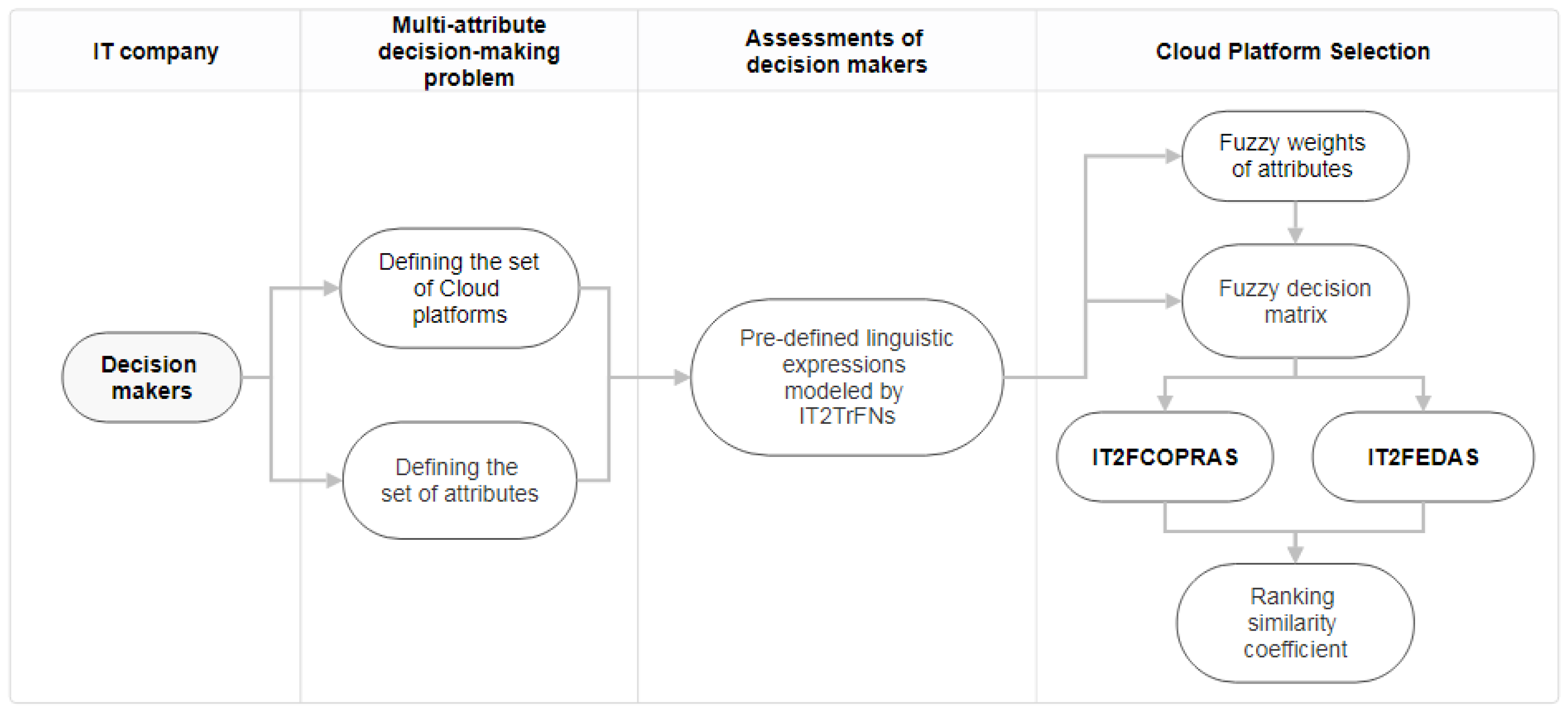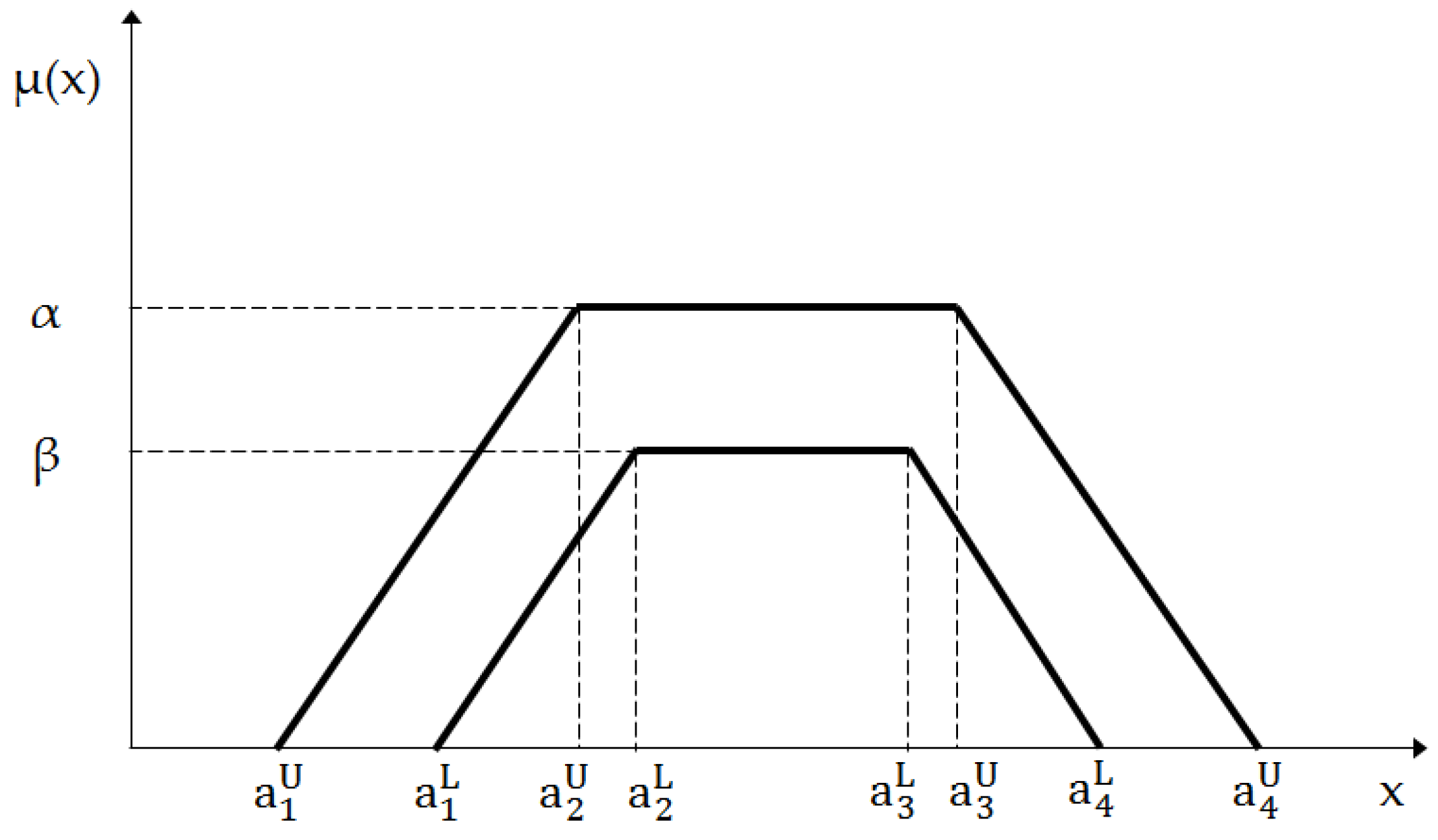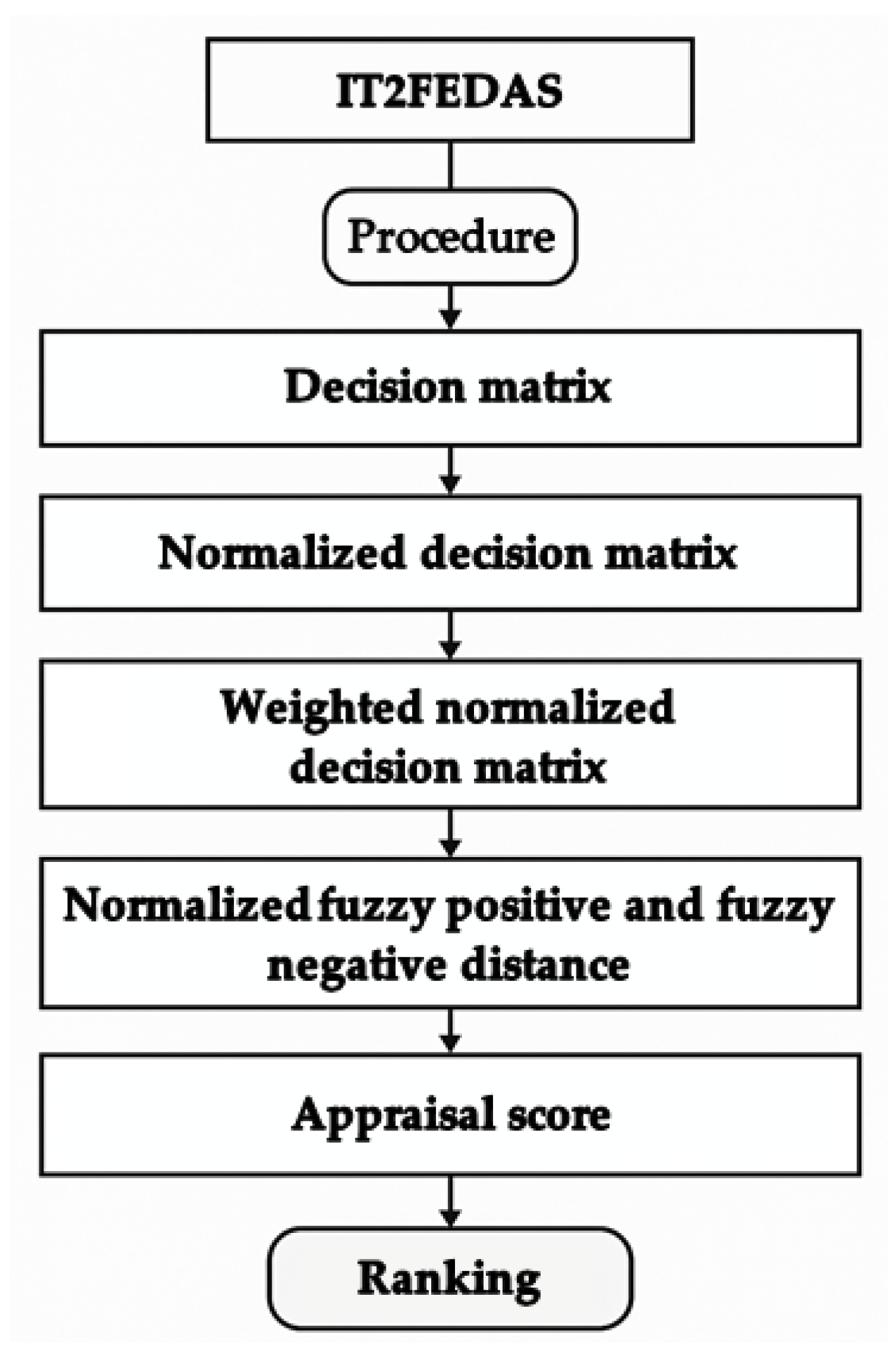Cloud Platform Selection Using Extended Multi-Attribute Decision-Making Methods with Interval Type-2 Fuzzy Sets
Abstract
1. Introduction
2. Literature Review
2.1. Application of MADM Methods in Cloud Platform Selection
2.2. Modeling of the Uncertain Data
2.3. Ranking by Applying IT2FCOPRAS
2.4. Ranking by Applying IT2FEDAS
3. Methodology
3.1. Preliminaries
3.2. Defining the Set of Decision-Makers
3.3. Defining the Set of Alternatives
3.4. Defining the Set of Attributes
- Performance and latency (the time period between sending a request for data retrieval and the moment when the data becomes available to a user or system) . This attribute depends on the server location;
- Unit price, measured per gigabyte on a monthly basis ;
- Security measures (data encryption, authentication, protection against attacks) ;
- Additional services (databases, analytics) ;
- Management and monitoring costs ;
- Scalability ;
- Trust and platform reputation .
3.5. Defining a Set of Linguistic Variables for Describing Uncertain Data
- Very low importance/values (L1):
- Low importance/values (L2):
- Fairly medium-low importance/values (L3):
- Medium importance/values (L4):
- Fairly medium-low importance/values (L5):
- High importance/values (L6):
- Very high importance/values (L7):
3.6. Determining the Weight Vectors
3.7. Determining the Rank of Cloud Platforms Using IT2FCOPRAS
3.8. Determining the Rank of Cloud Platforms Using IT2FEDAS
- benefit type
- cost type
- benefit type
- cost type
3.9. Determining the Similarity Ranking Coefficient
4. Case Study
- Excessive costs due to inefficient pricing or resource allocation.
- Limited scalability due to inflexibility or difficulty upgrading to larger resource capacity.
- Integration challenges due to platform incompatibility with existing applications and data processing processes.
- Insufficient data security might jeopardize safety and compliance with regulatory norms.
- Inefficient infrastructure management results in higher operational expenses and lost time.
- Insufficient data centers or geographical distance can lead to poor performance and negatively impact user experience.
4.1. Determination of the Weight Vectors
4.2. An Application of the Proposed IT2FCOPRAS
4.3. An Application of the Proposed IT2FEDAS
5. Conclusions
Author Contributions
Funding
Data Availability Statement
Conflicts of Interest
Abbreviations
| IT | Information Technology |
| IT2TrFNs | Interval Type-2 Trapezoidal Fuzzy Numbers |
| MADM | Multi-Attribute Decision-Making |
| IT2FMADM | MADM problems under an Interval Type-2 Fuzzy environment |
| DMs | Decision-makers |
| COPRAS | COmplex PRoportional Assessment |
| EDAS | Evaluation based on Distance from Average Solution |
| IT2FCOPRAS | COPRAS with Interval Type-2 Fuzzy Numbers |
| IT2FEDAS | EDAS with Interval Type-2 Fuzzy Numbers |
References
- Liu, S.; Chan, F.T.S.; Yang, J.; Niu, B. Understanding the Effect of Cloud Computing on Organizational Agility: An Empirical Examination. Int. J. Inf. Manag. 2018, 43, 98–111. [Google Scholar] [CrossRef]
- Islam, R.; Patamsetti, V.; Gadhi, A.; Gondu, R.M.; Bandaru, C.M.; Kesani, S.C.; Abiona, O. The Future of Cloud Computing: Benefits and Challenges. Int. J. Commun. Netw. Syst. Sci. 2023, 16, 53–65. [Google Scholar] [CrossRef]
- Zadeh, L.A. The Concept of a Linguistic Variable and Its Application to Approximate Reasoning—I. Inf. Sci. 1975, 8, 199–249. [Google Scholar] [CrossRef]
- Komatina, N. A Compromise-Based MADM Approach for Prioritizing Failures: Integrating the RADAR Method within the FMEA Framework. J. Sist. Manaj. Ind. 2024, 8, 73–88. [Google Scholar] [CrossRef]
- Tadić, D.; Lukić, J.; Komatina, N.; Marinković, D.; Pamučar, D. A Fuzzy Decision-Making Approach to Electric Vehicle Evaluation and Ranking. Teh. Vjesn./Tech. Gaz. 2025, 4, 1066–1075. [Google Scholar] [CrossRef]
- Nestić, S.; Aleksić, A.; Lafuente, J.G.; Cvetić, T.; Đurić, G. The Allocation of Business Model Components under Presence of Uncertainties by the Branch-and-Bound Method. Math. Probl. Eng. 2022, 2022, 2958519. [Google Scholar] [CrossRef]
- Komatina, N.; Marinković, D.; Tadić, D.; Pamučar, D. Advancing PFMEA Decision-Making: FRADAR Based Prioritization of Failure Modes Using AP, RPN, and Multi-Attribute Assessment in the Automotive Industry. Teh. Glas./Tech. J. 2025, 19, 442–451. [Google Scholar]
- Boral, S.; Chaturvedi, S.K.; Howard, I.; Naikan, V.N.A.; McKee, K. An Integrated Interval Type-2 Fuzzy Sets and Multiplicative Half Quadratic Programming-Based MCDM Framework for Calculating Aggregated Risk Ranking Results of Failure Modes in FMECA. Process Saf. Environ. Prot. 2021, 150, 194–222. [Google Scholar] [CrossRef]
- Wang, H.; Pan, X.; He, S. A New Interval Type-2 Fuzzy VIKOR Method for Multi-Attribute Decision Making. Int. J. Fuzzy Syst. 2019, 21, 145–156. [Google Scholar] [CrossRef]
- Sharaf, I.M. An Interval Type-2 Fuzzy TOPSIS Using the Extended Vertex Method for MAGDM. SN Appl. Sci. 2020, 2, 87. [Google Scholar] [CrossRef]
- Gojković, R.; Đurić, G.; Tadić, D.; Nestić, S.; Aleksić, A. Evaluation and Selection of the Quality Methods for Manufacturing Process Reliability Improvement—Intuitionistic Fuzzy Sets and Genetic Algorithm Approach. Mathematics 2021, 9, 1531. [Google Scholar] [CrossRef]
- Mishra, A.R.; Rani, P. Evaluating and Prioritizing Blockchain Networks Using Intuitionistic Fuzzy Multi-Criteria Decision-Making Method. Spectr. Mech. Eng. Oper. Res. 2025, 2, 78–92. [Google Scholar] [CrossRef]
- Khan, M.J.; Ding, W.; Jiang, S.; Akram, M. Group Decision Making Using Circular Intuitionistic Fuzzy Preference Relations. Expert Syst. Appl. 2025, 270, 126502. [Google Scholar] [CrossRef]
- Komatina, N.; Marinković, D. Optimization of PFMEA Team Composition in the Automotive Industry Using the IPF-RADAR Approach. Algorithms 2025, 18, 342. [Google Scholar] [CrossRef]
- Milošević, M.R.; Milošević, D.M.; Stević, D.M.; Kovačević, M. Interval Valued Pythagorean Fuzzy AHP Integrated Model in a Smartness Assessment Framework of Buildings. Axioms 2023, 12, 286. [Google Scholar] [CrossRef]
- Khan, M.J.; Ali, M.I.; Kumam, P.; Kumam, W.; Aslam, M.; Alcantud, J.C.R. Improved Generalized Dissimilarity Measure-based VIKOR Method for Pythagorean Fuzzy Sets. Int. J. Intell. Syst. 2022, 37, 1807–1845. [Google Scholar] [CrossRef]
- Wang, J.; Gao, H.; Wei, G.; Wei, Y. Methods for Multiple-Attribute Group Decision Making with q-Rung Interval-Valued Orthopair Fuzzy Information and Their Applications to the Selection of Green Suppliers. Symmetry 2019, 11, 56. [Google Scholar] [CrossRef]
- Jin, C.; Ran, Y.; Zhang, G. Interval-Valued q-Rung Orthopair Fuzzy FMEA Application to Improve Risk Evaluation Process of Tool Changing Manipulator. Appl. Soft Comput. 2021, 104, 107192. [Google Scholar] [CrossRef]
- Khan, M.J.; Kumam, P.; Alreshidi, N.A.; Kumam, W. Improved Cosine and Cotangent Function-Based Similarity Measures for q-Rung Orthopair Fuzzy Sets and TOPSIS Method. Complex Intell. Syst. 2021, 7, 2679–2696. [Google Scholar] [CrossRef]
- Aydin, N.; Seker, S.; Şen, C. A New Risk Assessment Framework for Safety in Oil and Gas Industry: Application of FMEA and BWM Based Picture Fuzzy MABAC. J. Pet. Sci. Eng. 2022, 219, 111059. [Google Scholar] [CrossRef]
- Khan, M.J.; Kumam, P.; Kumam, W.; Al-Kenani, A.N. Picture Fuzzy Soft Robust VIKOR Method and Its Applications in Decision-Making. Fuzzy Inf. Eng. 2021, 13, 296–322. [Google Scholar] [CrossRef]
- Mendel, J.M. Uncertain Rule-Based Fuzzy Systems: Introduction and New Directions, 2nd ed.; Springer International Publishing: Cham, Switzerland, 2017; ISBN 978-3-319-51369-0. [Google Scholar]
- Mendel, J.M.; John, R.I.B. Type-2 Fuzzy Sets Made Simple. IEEE Trans. Fuzzy Syst. 2002, 10, 117–127. [Google Scholar] [CrossRef]
- Dereli, T.; Altun, K. Technology Evaluation through the Use of Interval Type-2 Fuzzy Sets and Systems. Comput. Ind. Eng. 2013, 65, 624–633. [Google Scholar] [CrossRef]
- Aleksić, A.; Tadić, D. Industrial and Management Applications of Type-2 Multi-Attribute Decision-Making Techniques Extended with Type-2 Fuzzy Sets from 2013 to 2022. Mathematics 2023, 11, 2249. [Google Scholar] [CrossRef]
- Celik, E.; Gul, M.; Aydin, N.; Gumus, A.T.; Guneri, A.F. A Comprehensive Review of Multi Criteria Decision Making Approaches Based on Interval Type-2 Fuzzy Sets. Knowl.-Based Syst. 2015, 85, 329–341. [Google Scholar] [CrossRef]
- Mardani, A.; Jusoh, A.; Zavadskas, E.K. Fuzzy Multiple Criteria Decision-Making Techniques and Applications—Two Decades Review from 1994 to 2014. Expert Syst. Appl. 2015, 42, 4126–4148. [Google Scholar] [CrossRef]
- Çetinkaya, C.; Özkan, B.; Özceylan, E.; Haffar, S. An Eco-Friendly Evaluation for Locating Wheat Processing Plants: An Integrated Approach Based on Interval Type-2 Fuzzy AHP and COPRAS. Soft Comput. 2022, 26, 4081–4102. [Google Scholar] [CrossRef]
- Keshavarz Ghorabaee, M.; Amiri, M.; Salehi Sadaghiani, J.; Hassani Goodarzi, G. Multiple Criteria Group Decision-Making for Supplier Selection Based on COPRAS Method with Interval Type-2 Fuzzy Sets. Int. J. Adv. Manuf. Technol. 2014, 75, 1115–1130. [Google Scholar] [CrossRef]
- Keshavarz Ghorabaee, M.; Amiri, M.; Zavadskas, E.K.; Turskis, Z. Multi-Criteria Group Decision-Making Using an Extended EDAS Method with Interval Type-2 Fuzzy Sets. E+M Ekon. Manag. 2017, 20, 48–68. [Google Scholar] [CrossRef]
- Keshavarz Ghorabaee, M.; Amiri, M.; Zavadskas, E.K.; Turskis, Z.; Antucheviciene, J. A New Multi-Criteria Model Based on Interval Type-2 Fuzzy Sets and EDAS Method for Supplier Evaluation and Order Allocation with Environmental Considerations. Comput. Ind. Eng. 2017, 112, 156–174. [Google Scholar] [CrossRef]
- Oğuz, A. Drone Selection for Agricultural Enterprises with Interval Type-2 Fuzzy COPRAS Method. J. Res. Bus. 2024, 9, 395–421. [Google Scholar] [CrossRef]
- Toptancı, Ş.; Gündoğdu, H.G.; Korucuk, S.; Aytekin, A.; Stević, Ž. Corporate Sustainability Strategy Selection for a Metropolitan Municipality Using a Trapezoidal Interval Type-2 Fuzzy SWARA–COPRAS Framework. Soft Comput. 2023, 1–35. [Google Scholar] [CrossRef]
- Komatina, N. A Novel BWM-RADAR Approach for Multi-Attribute Selection of Equipment in the Automotive Industry. Spectr. Mech. Eng. Oper. Res. 2025, 2, 104–120. [Google Scholar] [CrossRef]
- Rakić, M.; Žižović, M.M.; Miljković, B.; Njeguš, A.; Žižović, M.R.; Đorđević, I. Multi-Criteria Selection of Standards for System Analyst Activities in Organizations. Facta Univ. Ser. Mech. Eng. 2023, 21, 433. [Google Scholar] [CrossRef]
- Božanić, D.; Epler, I.; Puška, A.; Biswas, S.; Marinković, D.; Koprivica, S. Application of the DIBR II—Rough MABAC Decision-Making Model for Ranking Methods and Techniques of Lean Organization Systems Management in the Process of Technical Maintenance. Facta Univ. Ser. Mech. Eng. 2024, 22, 101. [Google Scholar] [CrossRef]
- Radovanović, M.; Božanić, D.; Tešić, D.; Puška, A.; Hezam, I.M.; Jana, C. Application of Hybrid DIBR-FUCOM-LMAW-Bonferroni-Grey-EDAS Model in Multicriteria Decision-Making. Facta Univ. Ser. Mech. Eng. 2023, 21, 387. [Google Scholar] [CrossRef]
- Zavadskas, E.K.; Kaklauskas, A.; Turskis, Z.; Tamošaitiene, J. Selection of the Effective Dwelling House Walls by Applying Attributes Values Determined at Intervals. J. Civ. Eng. Manag. 2008, 14, 85–93. [Google Scholar] [CrossRef]
- Keshavarz Ghorabaee, M.; Zavadskas, E.K.; Olfat, L.; Turskis, Z. Multi-Criteria Inventory Classification Using a New Method of Evaluation Based on Distance from Average Solution (EDAS). Informatica 2015, 26, 435–451. [Google Scholar] [CrossRef]
- Yalcin, A.S.; Kilic, H.S.; Delen, D. The Use of Multi-Criteria Decision-Making Methods in Business Analytics: A Comprehensive Literature Review. Technol. Forecast. Soc. Change 2022, 174, 121193. [Google Scholar] [CrossRef]
- Sałabun, W.; Urbaniak, K. A New Coefficient of Rankings Similarity in Decision-Making Problems. In Proceedings of the Computational Science–ICCS 2020: 20th International Conference, Amsterdam, The Netherlands, 3 June 2020; Springer International Publishing: Berlin/Heidelberg, Germany, 2020; pp. 632–645. [Google Scholar]
- Więckowski, J.; Kizielewicz, B.; Shekhovtsov, A.; Sałabun, W. How Do the Criteria Affect Sustainable Supplier Evaluation?—A Case Study Using Multi-Criteria Decision Analysis Methods in a Fuzzy Environment. J. Eng. Manag. Syst. Eng. 2023, 2, 37–52. [Google Scholar] [CrossRef]
- Biswas, S.; Biswas, B.; Mitra, K. A Novel Group Decision Making Model to Compare Online Shopping Platforms. Spectr. Decis. Mak. Appl. 2025, 2, 1–27. [Google Scholar] [CrossRef]
- Žižović, M.; Miljković, B.; Marinković, D. Objective Methods for Determining Criteria Weight Coefficients: A Modification of the CRITIC Method. Decis. Mak. Appl. Manag. Eng. 2020, 3, 149–161. [Google Scholar] [CrossRef]
- Tricomi, G.; Merlino, G.; Panarello, A.; Puliafito, A. Optimal Selection Techniques for Cloud Service Providers. IEEE Access 2020, 8, 203591–203618. [Google Scholar] [CrossRef]
- Ganguly, P. Selecting the Right IoT Cloud Platform. In Proceedings of the 2016 International Conference on Internet of Things and Applications (IOTA), Pune, India, 22–24 January 2016; IEEE: New York, NY, USA; pp. 316–320. [Google Scholar]
- Chakraborty, A.; Jindal, M.; Khosravi, M.R.; Singh, P.; Shankar, A.; Diwakar, M. A Secure IoT-Based Cloud Platform Selection Using Entropy Distance Approach and Fuzzy Set Theory. Wirel. Commun. Mob. Comput. 2021, 2021, 6697467. [Google Scholar] [CrossRef]
- Ilieva, G.; Yankova, T.; Hadjieva, V.; Doneva, R.; Totkov, G. Cloud Service Selection as a Fuzzy Multi-Criteria Problem. TEM J. 2020, 9, 484–495. [Google Scholar] [CrossRef]
- Raheja, S.; Garg, R.; Garg, R. A Ranking Framework for the Selection of IoT Cloud Platforms Using Hybrid Multi-Attribute Decision-Making Method. Int. J. Intell. Comput. Cybern. 2024, 17, 824–843. [Google Scholar] [CrossRef]
- Saaty, T.L. The Modern Science of Multicriteria Decision Making and Its Practical Applications: The AHP/ANP Approach. Oper. Res. 2013, 61, 1101–1118. [Google Scholar] [CrossRef]
- Chen, S.-M.; Lee, L.-W. Fuzzy Multiple Attributes Group Decision-Making Based on the Interval Type-2 TOPSIS Method. Expert Syst. Appl. 2010, 37, 2790–2798. [Google Scholar] [CrossRef]
- Kahraman, C.; Öztayşi, B.; Uçal Sarı, İ.; Turanoğlu, E. Fuzzy Analytic Hierarchy Process with Interval Type-2 Fuzzy Sets. Knowl.-Based Syst. 2014, 59, 48–57. [Google Scholar] [CrossRef]
- Jahan, A.; Edwards, K.L. A State-of-the-Art Survey on the Influence of Normalization Techniques in Ranking: Improving the Materials Selection Process in Engineering Design. Mater. Des. (1980–2015) 2015, 65, 335–342. [Google Scholar] [CrossRef]
- Kuo, M.S.; Liang, G.S. A Soft Computing Method of Performance Evaluation with MCDM Based on Interval-Valued Fuzzy Numbers. Appl. Soft Comput. 2012, 12, 476–485. [Google Scholar] [CrossRef]
- Gardziejczyk, W.; Zabicki, P. Normalization and Variant Assessment Methods in Selection of Road Alignment Variants—Case Study. J. Civ. Eng. Manag. 2017, 23, 510–523. [Google Scholar] [CrossRef]
- Zavadskas, E.K.; Turskis, Z.; Antucheviciene, J. Optimization of Weighted Aggregated Sum Product Assessment. Electron. Electr. Eng. 2012, 122, 3–6. [Google Scholar] [CrossRef]





| The Normalized Weight Vectors | ||||
|---|---|---|---|---|
| L6 | L5 | L6 | ||
| L2 | L1 | L3 | ||
| L7 | L7 | L7 | ||
| L4 | L4 | L5 | ||
| L1 | L1 | L2 | ||
| L3 | L3 | L3 | ||
| L4 | L3 | L1 |
| L3 | 0.023 | L6 | L5 | L3 | L6 | L7 | |
| L3 | 0.018 | L4 | L3 | L1 | L3 | L6 | |
| L4 | 0.020 | L4 | L2 | L5 | L3 | L5 | |
| L6 | 0.025 | L5 | L5 | L7 | L4 | L2 |
| Rank | |||
|---|---|---|---|
| 1.416 | 2 | ||
| 1.561 | 1 | ||
| 1.156 | 3 | ||
| 0.876 | 4 |
| Rank | |||
|---|---|---|---|
| 0.398 | 1 | ||
| 0.166 | 2 | ||
| 0.088 | 3 | ||
| 0.044 | 4 |
Disclaimer/Publisher’s Note: The statements, opinions and data contained in all publications are solely those of the individual author(s) and contributor(s) and not of MDPI and/or the editor(s). MDPI and/or the editor(s) disclaim responsibility for any injury to people or property resulting from any ideas, methods, instructions or products referred to in the content. |
© 2025 by the authors. Licensee MDPI, Basel, Switzerland. This article is an open access article distributed under the terms and conditions of the Creative Commons Attribution (CC BY) license (https://creativecommons.org/licenses/by/4.0/).
Share and Cite
Spasenić, I.; Tadić, D.; Čabarkapa, M.; Marinković, D.; Komatina, N. Cloud Platform Selection Using Extended Multi-Attribute Decision-Making Methods with Interval Type-2 Fuzzy Sets. Axioms 2025, 14, 469. https://doi.org/10.3390/axioms14060469
Spasenić I, Tadić D, Čabarkapa M, Marinković D, Komatina N. Cloud Platform Selection Using Extended Multi-Attribute Decision-Making Methods with Interval Type-2 Fuzzy Sets. Axioms. 2025; 14(6):469. https://doi.org/10.3390/axioms14060469
Chicago/Turabian StyleSpasenić, Ivana, Danijela Tadić, Milan Čabarkapa, Dragan Marinković, and Nikola Komatina. 2025. "Cloud Platform Selection Using Extended Multi-Attribute Decision-Making Methods with Interval Type-2 Fuzzy Sets" Axioms 14, no. 6: 469. https://doi.org/10.3390/axioms14060469
APA StyleSpasenić, I., Tadić, D., Čabarkapa, M., Marinković, D., & Komatina, N. (2025). Cloud Platform Selection Using Extended Multi-Attribute Decision-Making Methods with Interval Type-2 Fuzzy Sets. Axioms, 14(6), 469. https://doi.org/10.3390/axioms14060469









